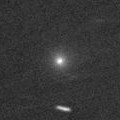
|
New bright comet. Now it is 9.7 mag (July 30, Michael Jager). Now it is not observable. It will appear in the morning sky in December, but it will be fainter than 15 mag at that time.
Date(TT) R.A. (2000) Decl. Delta r Elong. m1 Best Time(A, h)
Aug. 14 9 4.23 29 7.3 1.718 0.797 16 9.2 3:46 (231, -3)
Aug. 21 9 47.29 26 22.8 1.750 0.812 14 9.3 3:53 (232, -6)
|
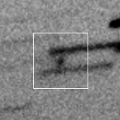
|
Now it is 11.2 mag (Aug. 10, Ken-ichi Kadota). Brightening very rapidly. It will brighten up to 8.5 mag from September to October. But the condition is bad in this apparition. In the Northern Hemisphere, it is observable only in the extremely low sky until August. In the Southern Hemisphere, it will be observable after late August. But it stays locating low for a while.
Date(TT) R.A. (2000) Decl. Delta r Elong. m1 Best Time(A, h)
Aug. 14 7 57.96 16 1.6 1.899 1.047 23 9.8 3:46 (251, 1)
Aug. 21 8 20.41 10 52.1 1.863 1.031 24 9.4 3:53 (257, 0)
|
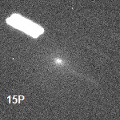
|
It brightened very rapidly. Now it is very bright as 11.1 mag (Aug. 6, Carlos Labordena). It stays 10 mag until August. It stays observable in the morning sky for a long time.
Date(TT) R.A. (2000) Decl. Delta r Elong. m1 Best Time(A, h)
Aug. 14 5 51.16 25 53.2 1.338 1.092 53 10.1 3:46 (258, 31)
Aug. 21 6 16.19 26 29.9 1.375 1.136 54 10.4 3:53 (259, 33)
|

|
Now it is very bright as 10.7 mag (Aug. 10, Chris Wyatt). It will be fading after this. In the Northern Hemisphere, it will be getting lower gradually in the evening. In the Southern Hemisphere, it stays observable in good condition for a while.
Date(TT) R.A. (2000) Decl. Delta r Elong. m1 Best Time(A, h)
Aug. 14 14 46.73 -9 2.5 1.999 2.094 80 10.6 20:22 ( 54, 28)
Aug. 21 14 58.38 -11 40.5 2.081 2.112 77 10.8 20:11 ( 53, 25)
|
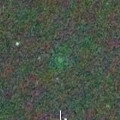
|
It brightened up to 4 mag in major outburst in 2016. Now it is very bright as 10.5 mag (Aug. 8, Rob Kaufman). In the Southern Hemisphere, it stays locating low in the evening sky until October. In the Northern Hemisphere, it stays locating extremely low.
Date(TT) R.A. (2000) Decl. Delta r Elong. m1 Best Time(A, h)
Aug. 14 12 2.80 2 39.3 1.702 1.107 38 10.7 20:22 ( 90, 4)
Aug. 21 12 32.15 0 21.3 1.734 1.150 39 10.9 20:11 ( 87, 5)
|

|
Now it is 11.2 mag (Aug. 6, Carlos Labordena). It will brighten up to 10 mag from summer to autumn, and it will be observable in excellent condition.
Date(TT) R.A. (2000) Decl. Delta r Elong. m1 Best Time(A, h)
Aug. 14 4 0.34 18 47.5 1.491 1.640 79 10.9 3:46 (283, 50)
Aug. 21 4 19.94 18 57.4 1.437 1.630 81 10.7 3:53 (286, 53)
|

|
Now it is 11.2 mag (Aug. 10, Osamu Miyazaki). It will brighten up to 10 mag in winter in 2022. In the Northern Hemisphere, it stays observable in good condition for a long time. In the Southern Hemisphere, it is not observable until November.
Date(TT) R.A. (2000) Decl. Delta r Elong. m1 Best Time(A, h)
Aug. 14 6 30.80 46 49.8 4.374 3.802 49 11.8 3:46 (232, 32)
Aug. 21 6 41.33 46 20.1 4.287 3.780 53 11.7 3:53 (234, 36)
|
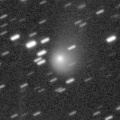
|
Now it is 13.2 mag (Aug. 10, Chris Wyatt). It is expected to be observable at 5-6 mag for a long time from 2022 to 2023. In the Northern Hemisphere, it is not observable at the high light from 2022 summer to 2023 summer. In the Southern Hemisphere, it stays extremely low for a while. But it will be observable in good condition at the high light.
Date(TT) R.A. (2000) Decl. Delta r Elong. m1 Best Time(A, h)
Aug. 14 17 2.11 36 14.5 5.377 5.614 98 12.1 20:22 (100, 79)
Aug. 21 16 59.64 34 52.4 5.377 5.555 94 12.1 20:11 ( 94, 75)
|

|
Now it is very bright as 11.7 mag (Aug. 10, Chris Wyatt). It stays bright as 10-12 mag until August. In the Southern Hemisphere, it stays observable in excellent condition for a long time. In the Northern Hemisphere, it becomes extremely low after this.
Date(TT) R.A. (2000) Decl. Delta r Elong. m1 Best Time(A, h)
Aug. 14 0 4.16 -50 27.6 0.674 1.553 132 12.3 2:35 ( 0, 5)
Aug. 21 23 58.30 -51 30.8 0.723 1.601 134 12.6 2:02 ( 0, 4)
|

|
Now it is 13.6 mag (Aug. 10, Chris Wyatt). It will brighten up to 9 mag, and will be observable in good condition in winter.
Date(TT) R.A. (2000) Decl. Delta r Elong. m1 Best Time(A, h)
Aug. 14 2 9.69 8 23.4 0.904 1.552 107 13.0 3:46 (332, 61)
Aug. 21 2 29.19 10 10.9 0.824 1.503 109 12.7 3:53 (338, 64)
|
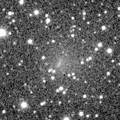
|
Now it is 13.4 mag (July 29, Thomas Lehmann). It will brighten very rapidly, and it will be observable at 10 mag in good condition from October to December. In the Northern Hemisphere, it locates somewhat low at the high light.
Date(TT) R.A. (2000) Decl. Delta r Elong. m1 Best Time(A, h)
Aug. 14 16 33.51 -4 10.2 0.752 1.413 105 13.5 20:22 ( 29, 46)
Aug. 21 16 45.65 -8 2.5 0.759 1.392 102 13.0 20:11 ( 29, 42)
|
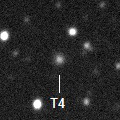
|
Now it is 14.6 mag (July 12, Chris Wyatt). It is expected to brighten up to 11.5 mag in 2022. In the Southern Hemisphere, it stas observable in good condition for a long time, although it becomes extremely low temporarily from August to September. In the Northern Hemisphere, it is not observable until November.
Date(TT) R.A. (2000) Decl. Delta r Elong. m1 Best Time(A, h)
Aug. 14 9 48.54 -22 18.1 5.677 4.905 36 13.7 20:22 ( 87,-38)
Aug. 21 9 56.46 -22 24.9 5.675 4.877 34 13.7 3:53 (273,-38)
|
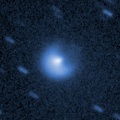
|
Now it is faint as 16.2 mag (Aug. 12, Jean-Francois Soulier).
Date(TT) R.A. (2000) Decl. Delta r Elong. m1 Best Time(A, h)
Aug. 14 4 43.12 30 37.0 6.208 5.904 68 13.7 3:46 (260, 46)
Aug. 21 4 46.78 30 50.0 6.107 5.906 73 13.7 3:53 (264, 53)
|
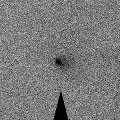
|
It brightened up to 10.1 mag in spring (Apr. 10, Marco Goiato). Now it is fading. It has already faded down to 14.8 mag (Aug. 10, Chris Wyatt). It stays observable in good condition for a long time after this while the comet will fading.
Date(TT) R.A. (2000) Decl. Delta r Elong. m1 Best Time(A, h)
Aug. 14 4 18.65 9 1.9 1.964 1.998 77 14.1 3:46 (290, 41)
Aug. 21 4 27.82 8 59.6 1.931 2.042 81 14.2 3:53 (296, 46)
|

|
Now it is 14.5 mag (Aug. 10, Chris Wyatt). It stays 13-14 mag from 2020 to 2021. It will be observable in good condition after this in the Southern Hemisphere. It locates somewhat low in the Northern Hemisphere.
Date(TT) R.A. (2000) Decl. Delta r Elong. m1 Best Time(A, h)
Aug. 14 18 44.47 -35 31.2 2.191 3.009 136 14.1 21:13 ( 0, 19)
Aug. 21 18 43.48 -35 35.5 2.269 3.020 129 14.2 20:44 ( 0, 19)
|
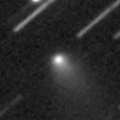
|
Now it is 14.0 mag (Aug. 3, Hirohisa Sato). It will brighten up to 14 mag in summer, and it will be observable in excellent condition. It locates somewhat low in the Southern Hemisphere.
Date(TT) R.A. (2000) Decl. Delta r Elong. m1 Best Time(A, h)
Aug. 14 17 26.89 30 39.7 1.861 2.344 105 14.2 20:22 ( 55, 83)
Aug. 21 17 6.25 29 8.3 1.962 2.330 98 14.3 20:11 ( 71, 75)
|

|
Outburst occured in early August. Now it is very bright as 14.1 mag (Aug. 7, Michael Jager). In the Northern Hemisphere, it stays observable in good condition. In the Southern Hemipsphere, it stays locating extremely low after this.
Date(TT) R.A. (2000) Decl. Delta r Elong. m1 Best Time(A, h)
Aug. 14 4 46.46 39 55.3 2.674 2.462 67 14.3 3:46 (247, 48)
Aug. 21 4 58.54 40 46.7 2.625 2.488 71 14.4 3:53 (247, 53)
|

|
Now it is bright as 13.2 mag (Aug. 6, Chris Wyatt). It will be getting lower rapidly after this, and it will be unobservable in September.
Date(TT) R.A. (2000) Decl. Delta r Elong. m1 Best Time(A, h)
Aug. 14 13 41.04 -5 59.3 3.845 3.530 64 14.3 20:22 ( 69, 18)
Aug. 21 13 41.70 -5 21.5 3.986 3.551 57 14.5 20:11 ( 72, 15)
|
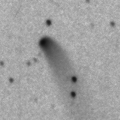
|
Now it is 14.4 mag (Aug. 10, Chris Wyatt). It stays 14-15 mag until the end of 2021. In the Southern Hemisphere, it stays observable in good condition for a long time. It locates low in the Northern Hemisphere.
Date(TT) R.A. (2000) Decl. Delta r Elong. m1 Best Time(A, h)
Aug. 14 23 19.49 -33 42.6 3.582 4.484 149 14.6 1:51 ( 0, 21)
Aug. 21 23 13.18 -33 25.8 3.574 4.499 153 14.6 1:17 ( 0, 22)
|
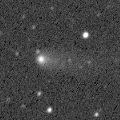
|
Now it is 14.9 mag (Aug. 10, Chris Wyatt). It was expected to brighten up to 13 mag from spring to summer. But actually, it is fainter than originally expected. It stays 14-15 mag until early autumn. In the Southern Hemisphere, it stays observable in good condition for a long time. In the Northern Hemisphere, it is not observable until July in 2022.
Date(TT) R.A. (2000) Decl. Delta r Elong. m1 Best Time(A, h)
Aug. 14 22 9.14 -87 36.2 3.202 3.627 106 14.8 0:48 ( 0,-33)
Aug. 21 21 22.16 -87 6.6 3.239 3.636 105 14.8 23:25 ( 0,-32)
|

|
Now it is 14.8 mag (Aug. 6, Hirohisa Sato). It stays at 14-15 mag for a long time from 2021 to 2022. It stays observable in good condition after this while brightening gradually.
Date(TT) R.A. (2000) Decl. Delta r Elong. m1 Best Time(A, h)
Aug. 14 16 28.29 -11 46.8 4.660 5.032 105 14.9 20:22 ( 27, 39)
Aug. 21 16 25.27 -12 47.1 4.772 5.025 98 14.9 20:11 ( 32, 36)
|
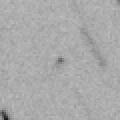
|
Now it is 17.0 mag (Aug. 4, Slooh.com Chile Observatory, La Dehesa). It will brighten rapidly up to 9 mag in winter. It will be observable in good condition.
Date(TT) R.A. (2000) Decl. Delta r Elong. m1 Best Time(A, h)
Aug. 14 0 18.34 -51 2.5 1.474 2.269 130 15.2 2:49 ( 0, 4)
Aug. 21 0 16.92 -53 0.7 1.418 2.217 130 14.9 2:21 ( 0, 2)
|
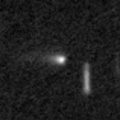
|
Now it is 16.2 mag (July 30, Thomas Lehmann). It will approach to Earth down to 0.2 a.u. in December, and it is expected to brighten up to 4 mag. In the Northern Hemisphere, it stays observable in good condition for a long time until December while the comet is brightening gradually. In the Southern Hemisphere, it is not observable until mid December.
Date(TT) R.A. (2000) Decl. Delta r Elong. m1 Best Time(A, h)
Aug. 14 10 42.45 44 3.0 3.315 2.526 32 15.1 20:22 (135, 13)
Aug. 21 10 46.77 42 59.6 3.226 2.432 32 14.9 20:11 (136, 10)
|

|
Now it is 15.6 mag (July 16, Ken-ichi Kadota). It stays 15 mag from summer to autumn. In the Northern Hemisphere, it stays observable in good condition for a long time. In the Southern Hemisphere, it will be getting lower gradually after this.
Date(TT) R.A. (2000) Decl. Delta r Elong. m1 Best Time(A, h)
Aug. 14 5 3.45 19 53.1 1.663 1.529 64 15.2 3:46 (271, 38)
Aug. 21 5 23.84 21 38.6 1.623 1.529 66 15.2 3:53 (271, 42)
|
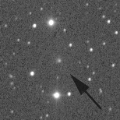
|
It brightened up to 14.2 mag in early summer (June 10, Thomas Lehmann). Now it is not observable. It will be fading after this. In the Northern Hemisphere, it will appear in the morning sky at 16 mag in October. In the Southern Hemisphere, it will never be observable again.
Date(TT) R.A. (2000) Decl. Delta r Elong. m1 Best Time(A, h)
Aug. 14 10 24.61 17 35.7 2.978 2.001 12 15.4 20:22 (117, -7)
Aug. 21 10 38.71 18 37.7 3.001 2.018 11 15.4 20:11 (118, -7)
|
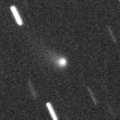
|
Now it is 15.4 mag (July 17, Thomas Lehmann). In the Northern Hemisphere, it stays observable at 15-16 mag for a long time from spring to early 2022. In the Southern Hemisphere, it is not observable until the end of 2021.
Date(TT) R.A. (2000) Decl. Delta r Elong. m1 Best Time(A, h)
Aug. 14 12 27.98 45 20.0 3.590 3.005 47 15.4 20:22 (127, 30)
Aug. 21 12 31.01 42 40.8 3.639 3.004 44 15.5 20:11 (125, 26)
|

|
Now it is 15.8 mag (July 30, Thomas Lehmann). It will brighten up to 13 mag in 2022. In 2021, it is observable at 14-15 mag in good condition.
Date(TT) R.A. (2000) Decl. Delta r Elong. m1 Best Time(A, h)
Aug. 14 13 32.11 -6 44.0 3.763 3.419 62 15.5 20:22 ( 70, 16)
Aug. 21 13 38.75 -7 36.0 3.834 3.405 57 15.5 20:11 ( 71, 13)
|
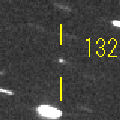
|
Now it is 17.2 mag (Aug. 5, F. Kugel, J.-G. Bosch). It will brighten very rapidly up to 14 mag, and it will be observable in excellent condition in autumn.
Date(TT) R.A. (2000) Decl. Delta r Elong. m1 Best Time(A, h)
Aug. 14 0 15.44 3 38.3 1.047 1.911 136 15.8 2:46 ( 0, 59)
Aug. 21 0 19.52 3 34.6 0.978 1.881 141 15.5 2:23 ( 0, 59)
|

|
It will brighten up to 14.5 mag from spring to summer. In the Southern Hemisphere, it stays observable in excellent condition for a long time. In the Northern Hemisphere, it is not observable after this.
Date(TT) R.A. (2000) Decl. Delta r Elong. m1 Best Time(A, h)
Aug. 14 9 56.29 -57 25.3 3.050 2.902 72 15.5 20:22 ( 41,-44)
Aug. 21 10 12.76 -56 5.6 3.151 2.932 68 15.6 20:11 ( 43,-44)
|
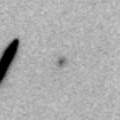
|
Now it is 15.5 mag (July 27, Ken-ichi Kadota). It will brighten rapidly up to 15 mag in autumn. It will be observable in excellent condition in the Northern Hemisphere. It locates somewhat low in the Southern Hemisphere.
Date(TT) R.A. (2000) Decl. Delta r Elong. m1 Best Time(A, h)
Aug. 14 4 17.32 17 1.9 1.615 1.682 75 15.7 3:46 (282, 46)
Aug. 21 4 35.18 18 23.2 1.558 1.672 78 15.5 3:53 (284, 50)
|

|
Now it is 16.3 mag (July 25, J. L. Virlichie, P. Traverse, H. Roy, J. P. Desgrees). It is expected to brighten up to 13 mag in 2022. In the Southern Hemisphere, it stays observable in good condition for a long time. In the Northern Hemisphere, it is not observable for a while.
Date(TT) R.A. (2000) Decl. Delta r Elong. m1 Best Time(A, h)
Aug. 14 12 2.98 -22 59.6 4.811 4.266 52 15.7 20:22 ( 69,-11)
Aug. 21 12 4.82 -23 39.3 4.848 4.224 47 15.7 20:11 ( 71,-15)
|
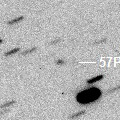
|
Now it is 16.7 mag (July 17, Ken-ichi Kadota). It will brighten up to 15.5 mag from summer to autumn. It stays observable for a long time.
Date(TT) R.A. (2000) Decl. Delta r Elong. m1 Best Time(A, h)
Aug. 14 15 42.92 -15 58.3 1.409 1.819 95 15.8 20:22 ( 37, 30)
Aug. 21 15 54.34 -16 42.2 1.452 1.800 92 15.7 20:11 ( 38, 29)
|

|
It brightened up to 11.6 mag in winter (Feb. 18, Thomas Lehmann). Now it is fading. It has already faded down to 15.6 mag (July 29, Thomas Lehmann). In the Southern Hemisphere, it stays observable in good condition after this. In the Northern Hemisphere, it will never be observable after this.
Date(TT) R.A. (2000) Decl. Delta r Elong. m1 Best Time(A, h)
Aug. 14 5 32.34 -59 18.9 3.394 3.514 88 15.8 3:46 (331,-18)
Aug. 21 5 30.09 -60 47.9 3.431 3.579 90 15.9 3:53 (335,-16)
|

|
Now it is 15.7 mag (July 17, Toshiyuki Takahashi). It stays observable at 15-16 mag in good condition until autumn.
Date(TT) R.A. (2000) Decl. Delta r Elong. m1 Best Time(A, h)
Aug. 14 16 29.73 -13 2.8 4.479 4.864 106 15.8 20:22 ( 26, 38)
Aug. 21 16 29.96 -12 20.4 4.589 4.863 99 15.8 20:11 ( 31, 37)
|
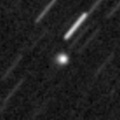
|
Now it is 16.1 mag (Aug. 2, ATLAS-HKO, Haleakala). It is expected to brighten up to 11 mag in 2023. In the Northern Hemisphere, it stays observable in good condition for a long time. It locates extremely low in the Southern Hemisphere.
Date(TT) R.A. (2000) Decl. Delta r Elong. m1 Best Time(A, h)
Aug. 14 16 17.67 45 18.0 6.179 6.212 87 15.9 20:22 (126, 69)
Aug. 21 16 13.65 44 10.4 6.193 6.168 83 15.8 20:11 (121, 66)
|

|
Now it is 16.1 mag (July 26, J. L. Virlichie, P. Traverse, H. Roy, J. P. Desgrees). It will brighten up to 12.5 mag in 2022 summer. In the Southern Hemisphere, it stays observable in excellent condition for a long time. In the Northern Hemisphere, it is not observable until August in 2022.
Date(TT) R.A. (2000) Decl. Delta r Elong. m1 Best Time(A, h)
Aug. 14 4 1.73 -56 51.5 4.544 4.797 98 16.1 3:46 (338, -8)
Aug. 21 4 1.63 -58 60.0 4.464 4.749 100 16.0 3:53 (344, -8)
|
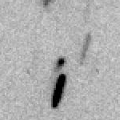
|
Now it is 15.8 mag (Aug. 3, Ken-ichi Kadota). It stays observable at 16 mag in good condition until autumn.
Date(TT) R.A. (2000) Decl. Delta r Elong. m1 Best Time(A, h)
Aug. 14 23 23.13 -8 43.3 1.357 2.305 152 16.1 1:54 ( 0, 46)
Aug. 21 23 21.51 -9 52.7 1.325 2.301 159 16.1 1:25 ( 0, 45)
|
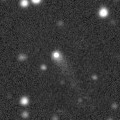
|
Now it is 16.0 mag (July 18, Ken-ichi Kadota). It stays observable at 16 mag from 2021 to 2022.
Date(TT) R.A. (2000) Decl. Delta r Elong. m1 Best Time(A, h)
Aug. 14 13 50.06 2 10.4 5.069 4.718 64 16.1 20:22 ( 74, 25)
Aug. 21 13 53.82 2 27.9 5.161 4.714 58 16.2 20:11 ( 77, 22)
|

|
Now it is 16.6 mag (July 18, Thomas Lehmann). It is observable at 16 mag from 2020 to 2021. It locates low in the Southern Hemisphere.
Date(TT) R.A. (2000) Decl. Delta r Elong. m1 Best Time(A, h)
Aug. 14 22 32.04 43 38.5 5.482 6.058 120 16.3 1:04 (180, 81)
Aug. 21 22 24.57 42 51.1 5.435 6.067 124 16.3 0:29 (180, 82)
|

|
Now it is 16.0 mag (July 20, Thomas Lehmann). In the Northern Hemisphere, it stays observable for a long time while it is getting fainter slowly. In the Southern Hemisphere, it will never be observable again.
Date(TT) R.A. (2000) Decl. Delta r Elong. m1 Best Time(A, h)
Aug. 14 13 36.48 51 19.0 6.939 6.501 60 16.3 20:22 (130, 42)
Aug. 21 13 39.36 50 7.5 7.022 6.549 58 16.4 20:11 (129, 40)
|
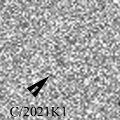
|
Now it is 15.9 mag (Aug. 2, ATLAS-MLO, Mauna Loa). It will be fading after this, and it will be fainter than 18 mag in November.
Date(TT) R.A. (2000) Decl. Delta r Elong. m1 Best Time(A, h)
Aug. 14 1 13.26 -6 33.3 1.964 2.684 125 16.4 3:44 ( 0, 49)
Aug. 21 1 15.37 -7 26.8 1.928 2.709 131 16.4 3:19 ( 0, 48)
|
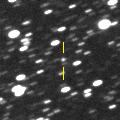
|
Now it is 16.1 mag (Aug. 2, F. Kugel, J.-G. Bosch). It is expected to brighten up to 11 mag from spring to summer in 2022. In the Southen Hemisphere, it locates somewhat low in 2021, but it will be observable in good condition at the high light for a long time. In the Northern Hemisphere, it is observable in good condition in 2021, but it will not be observable at the high light.
Date(TT) R.A. (2000) Decl. Delta r Elong. m1 Best Time(A, h)
Aug. 14 19 19.93 32 11.7 3.291 3.940 123 16.5 21:47 ( 0, 87)
Aug. 21 19 10.47 30 13.8 3.256 3.877 121 16.4 21:10 ( 0, 85)
|

|
Now it is 16.1 mag (July 20, E. Bryssinck). It stays at 16-17 mag from 2020 to 2021. In the Northern Hemisphere, it stays observable in good condition for a long time. It locates extremely low in the Southern Hemisphere.
Date(TT) R.A. (2000) Decl. Delta r Elong. m1 Best Time(A, h)
Aug. 14 18 37.94 51 31.6 8.572 8.867 103 16.5 21:05 (180, 73)
Aug. 21 18 33.58 51 18.5 8.600 8.872 102 16.5 20:33 (180, 74)
|
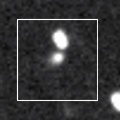
|
Now it is 16.6 mag (July 29, Thomas Lehmann). It is expected to brighten up to 10 mag in 2023. In the Northern Hemisphere, it stays observable in good condition until 2023 autumn. In the Southern Hemipshere, it stays unobservable until 2023 summer.
Date(TT) R.A. (2000) Decl. Delta r Elong. m1 Best Time(A, h)
Aug. 14 12 7.31 35 17.4 7.339 6.597 40 16.5 20:22 (119, 22)
Aug. 21 12 9.71 34 57.9 7.321 6.543 37 16.5 20:11 (120, 19)
|

|
Announced as a bright Centaur-type asteroid. But Hidetaka Sato revealed that this is Phoebe, one of the satellites of Saturn.
Date(TT) R.A. (2000) Decl. Delta r Elong. m1 Best Time(A, h)
Aug. 14 20 48.72 -18 38.9 8.881 9.875 168 16.5 23:16 ( 0, 36)
Aug. 21 20 46.86 -18 46.9 8.913 9.876 161 16.6 22:47 ( 0, 36)
|

|
Now it is 16.8 mag (July 18, Toshihiko Ikemura, Hirohisa Sato). It is expected to brighten up to 11 mag in 2023. In the Northern Hemisphere, it is observable in good condition in 2021. But it is observable only until November in 2022. In the Southern Hemisphere, it locates extremely low in 2021. But it will be observable in good condition at the high light.
Date(TT) R.A. (2000) Decl. Delta r Elong. m1 Best Time(A, h)
Aug. 14 17 32.35 40 8.0 6.157 6.441 101 16.7 20:22 (141, 83)
Aug. 21 17 29.63 38 53.0 6.156 6.393 99 16.6 20:11 (117, 81)
|
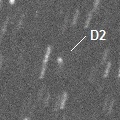
|
Now it is 17.1 mag (Aug. 2, ATLAS-HKO, Haleakala). It will brighten up to 15.5 mag in winter. In the Northern Hemisphere, it stays observable in good condition for a long time. It is not observable at all in the Southern Hemisphere.
Date(TT) R.A. (2000) Decl. Delta r Elong. m1 Best Time(A, h)
Aug. 14 17 10.01 73 44.8 3.392 3.413 82 16.7 20:22 (175, 51)
Aug. 21 16 43.30 72 49.2 3.377 3.379 81 16.6 20:11 (170, 51)
|

|
Now it is 16.5 mag (July 29, ATLAS-HKO, Haleakala). Fading slowly. In the Northern Hemisphere, it stays observable in good condition for a long time. It is not observable after this in the Southern Hemisphere.
Date(TT) R.A. (2000) Decl. Delta r Elong. m1 Best Time(A, h)
Aug. 14 16 28.37 55 2.6 5.584 5.601 85 16.6 20:22 (150, 65)
Aug. 21 16 23.13 54 13.9 5.659 5.633 83 16.7 20:11 (144, 63)
|
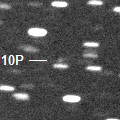
|
Now it is 18.0 mag (Aug. 1, Palomar Mountain--ZTF). Appearing in the morning sky. It will brightens rapidly. And it will be observable at 15 mag in excellent condition in winter.
Date(TT) R.A. (2000) Decl. Delta r Elong. m1 Best Time(A, h)
Aug. 14 6 17.91 28 20.2 3.060 2.489 47 16.8 3:46 (253, 27)
Aug. 21 6 31.62 28 1.0 2.990 2.482 51 16.7 3:53 (256, 31)
|
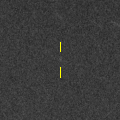
|
Now it is 15.9 mag (Aug. 4, Purple Mountain Observatory, XuYi Station). It will brighten up to 16.5 mag in autumn and it will be observable in good condition.
Date(TT) R.A. (2000) Decl. Delta r Elong. m1 Best Time(A, h)
Aug. 14 23 34.52 -1 21.1 1.246 2.170 147 16.8 2:06 ( 0, 54)
Aug. 21 23 31.08 -0 45.8 1.210 2.168 154 16.7 1:35 ( 0, 54)
|

|
It brightened up to 3 mag in December in the SOHO spacecraft images (Dec. 18, Hirohisa Sato). Now it is 16.2 mag (July 22, ATLAS-MLO, Mauna Loa). It stays observable in good condition after this while the comet will be fading.
Date(TT) R.A. (2000) Decl. Delta r Elong. m1 Best Time(A, h)
Aug. 14 0 4.00 19 51.0 3.206 3.930 129 16.7 2:35 ( 0, 75)
Aug. 21 23 58.41 19 29.4 3.211 4.011 136 16.8 2:02 ( 0, 75)
|
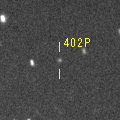
|
First return of a new periodic comet observed at 16 mag from 2003 to 2004. Now it is 16.8 mag (Apr. 11, J. Drummond). It will brighten up to 16 mag in winter, and it will be observable in excellent condition. It will be getting higher gradually.
Date(TT) R.A. (2000) Decl. Delta r Elong. m1 Best Time(A, h)
Aug. 14 5 54.35 2 25.5 4.485 4.000 55 16.8 3:46 (280, 18)
Aug. 21 6 1.14 2 22.5 4.402 3.993 59 16.7 3:53 (284, 23)
|

|
It stays observable at 16 mag from autumn to winter. In the Northern Hemisphere, it stays observable in good condition. In the Southern Hemisphere, it stays extremely low until November.
Date(TT) R.A. (2000) Decl. Delta r Elong. m1 Best Time(A, h)
Aug. 14 7 22.63 28 47.4 2.601 1.844 33 16.9 3:46 (245, 15)
Aug. 21 7 43.03 27 57.4 2.552 1.828 35 16.7 3:53 (247, 17)
|
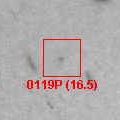
|
Now it is 18.9 mag (Aug. 3, ATLAS-HKO, Haleakala). It will brighten up to 14.5 mag in 2022 winter. In 2021, it stays observable in good condition while the comet will be brightening gradually. It is fainter than this ephemeris recently.
Date(TT) R.A. (2000) Decl. Delta r Elong. m1 Best Time(A, h)
Aug. 14 22 59.68 -15 9.4 2.308 3.275 159 17.0 1:31 ( 0, 40)
Aug. 21 22 55.58 -15 50.7 2.258 3.249 166 16.9 1:00 ( 0, 39)
|

|
Now it is 19.4 mag (Aug. 12, Thomas Lehmann). It will brightens rapidly. And it is expected to be observable at 10-11 mag in good condition from December to February.
Date(TT) R.A. (2000) Decl. Delta r Elong. m1 Best Time(A, h)
Aug. 14 22 42.92 1 22.0 1.111 2.081 156 17.4 1:14 ( 0, 56)
Aug. 21 22 37.17 0 57.9 1.030 2.022 163 17.0 0:41 ( 0, 56)
|

|
Appearing in the morning sky. Now it is 17.3 mag (Aug. 2, F. Kugel, J.-G. Bosch). In the Northern Hemisphere, it stays observable at 17 mag in good condition until winter. In the Southern Hemisphere, it stays locating extremely low for a while.
Date(TT) R.A. (2000) Decl. Delta r Elong. m1 Best Time(A, h)
Aug. 14 6 11.24 37 48.5 2.407 1.926 50 17.2 3:46 (244, 32)
Aug. 21 6 31.36 37 25.5 2.369 1.934 52 17.2 3:53 (245, 35)
|

|
It had been observed as 8-9 mag for a long time in 2020. Now it is fading. It has already faded down to 17.6 mag (July 29, J. Drummond). It will be observable in good condition after this in the Southern Hemisphere. It locates extremely low after this in the Northern Hemisphere.
Date(TT) R.A. (2000) Decl. Delta r Elong. m1 Best Time(A, h)
Aug. 14 16 7.38 -45 35.6 5.083 5.450 106 17.2 20:22 ( 18, 6)
Aug. 21 16 7.77 -45 26.5 5.245 5.511 99 17.3 20:11 ( 21, 5)
|

|
Now it is 16.7 mag (July 18, Toshihiko Ikemura, Hirohisa Sato). In the Northern Hemisphere, it stays observable in good condition after this while the comet will be fading. In the Southern Hemisphere, it stays locating extremely low for a long time.
Date(TT) R.A. (2000) Decl. Delta r Elong. m1 Best Time(A, h)
Aug. 14 4 40.80 34 11.9 2.548 2.368 68 17.2 3:46 (256, 48)
Aug. 21 4 50.76 35 5.2 2.521 2.422 72 17.2 3:53 (256, 53)
|

|
Now it is 16.6 mag (July 25, ATLAS-MLO, Mauna Loa). It will be fading after this, and it will be fainter than 18 mag in October.
Date(TT) R.A. (2000) Decl. Delta r Elong. m1 Best Time(A, h)
Aug. 14 15 13.07 -21 46.8 5.033 5.144 90 17.3 20:22 ( 40, 22)
Aug. 21 15 10.97 -22 11.4 5.184 5.168 83 17.3 20:11 ( 44, 19)
|
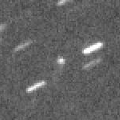
|
It will brighten up to 16 mag in 2022. In the Northern Hemisphere, it stays observable in good condition for a long time. In the Southern Hemisphere, it is not observable until 2023.
Date(TT) R.A. (2000) Decl. Delta r Elong. m1 Best Time(A, h)
Aug. 14 7 52.62 47 27.8 5.116 4.377 39 17.5 3:46 (225, 19)
Aug. 21 8 0.52 48 21.2 5.019 4.347 43 17.4 3:53 (227, 24)
|
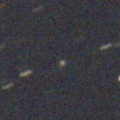
|
Now it is 17.7 mag (July 25, Michael Jager). It stays observable at 17-18 mag for a long time until 2024.
Date(TT) R.A. (2000) Decl. Delta r Elong. m1 Best Time(A, h)
Aug. 14 14 19.23 -5 20.2 9.268 9.030 73 17.4 20:22 ( 63, 25)
Aug. 21 14 18.91 -5 19.6 9.375 9.021 66 17.5 20:11 ( 66, 22)
|

|
First return of a new periodic comet which brightened up to 17 mag in 2012. Now it is 18.3 mag (July 10, ATLAS-HKO, Haleakala). In the Southern Hemisphere, it is observable at 17.5 mag in excellent condition in summer. It locates low in the Northern Hemisphere.
Date(TT) R.A. (2000) Decl. Delta r Elong. m1 Best Time(A, h)
Aug. 14 19 35.74 -41 22.9 0.730 1.654 142 17.5 22:04 ( 0, 14)
Aug. 21 19 32.67 -41 31.8 0.718 1.610 136 17.5 21:33 ( 0, 14)
|
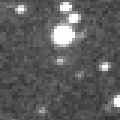
|
Now it is 16.9 mag (July 19, ATLAS-HKO, Haleakala)�$B!#�(BIt stays observable at 17-18 mag for a long time from 2021 to 2022.
Date(TT) R.A. (2000) Decl. Delta r Elong. m1 Best Time(A, h)
Aug. 14 19 7.42 -18 35.9 3.261 4.129 144 17.5 21:35 ( 0, 36)
Aug. 21 19 5.66 -18 41.9 3.320 4.123 137 17.5 21:06 ( 0, 36)
|
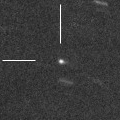
|
Now it is 17.9 mag (July 18, Toshihiko Ikemura, Hirohisa Sato). It is observable at 17 mag in good condition in autumn.
Date(TT) R.A. (2000) Decl. Delta r Elong. m1 Best Time(A, h)
Aug. 14 2 24.78 18 47.4 3.528 3.854 101 17.6 3:46 (312, 68)
Aug. 21 2 27.67 18 51.8 3.427 3.849 107 17.5 3:53 (330, 72)
|
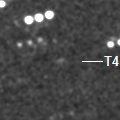
|
Now it is extremely faint as 20.5 mag (June 17, M. Jaeger, E. Prosperi, S. Prosperi). It was predicted to brighten up to 17.5 mag in 2021 summer. But actually, it is much fainter than predicted. It is not observable in the Southern Hemisphere.
Date(TT) R.A. (2000) Decl. Delta r Elong. m1 Best Time(A, h)
Aug. 14 13 5.92 62 27.5 2.556 2.240 60 17.5 20:22 (145, 39)
Aug. 21 13 26.70 58 1.3 2.588 2.258 59 17.6 20:11 (139, 39)
|

|
Now it is 16.4 mag (July 31, ATLAS-HKO, Haleakala). It will be fading slowly.
Date(TT) R.A. (2000) Decl. Delta r Elong. m1 Best Time(A, h)
Aug. 14 16 59.66 -11 7.9 7.480 7.935 113 17.6 20:22 ( 18, 42)
Aug. 21 16 57.20 -11 0.2 7.622 7.961 106 17.7 20:11 ( 24, 41)
|
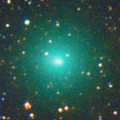
|
It brightened up to 8.2 mag in 2020 autumn (Oct. 13, 2020, Chris Wyatt). Now it is 18.9 mag (July 15, Palomar Mountain--ZTF). It is observable at 18 mag in 2021.
Date(TT) R.A. (2000) Decl. Delta r Elong. m1 Best Time(A, h)
Aug. 14 4 52.72 22 34.1 3.371 3.112 66 17.7 3:46 (269, 41)
Aug. 21 4 58.77 22 48.0 3.313 3.150 71 17.8 3:53 (273, 47)
|

|
First return of a new periodic comet which brightened up to 17 mag in 2006. Now it is 17.4 mag (June 15, Taras Prystavski). It stays 18 mag from 2021 to 2022.
Date(TT) R.A. (2000) Decl. Delta r Elong. m1 Best Time(A, h)
Aug. 14 22 19.62 -69 42.8 2.600 3.279 124 17.7 0:52 ( 0,-15)
Aug. 21 22 8.88 -69 36.7 2.606 3.264 122 17.7 0:14 ( 0,-15)
|

|
It brightened up to 18.5 mag in 2020 spring (Apr. 2, 2020, W. Hasubick). Now it is 19.3 mag (July 16, J. P. Desgrees, J. L. Virlichie, P. Traverse, H. Roy). It has passed the perihelion in 2020 October. At the discovery in 2005, it stayed bright for several years even after the perihelion passage. In this apparition, it may stay observable at 18 mag from 2021 to 2024.
Date(TT) R.A. (2000) Decl. Delta r Elong. m1 Best Time(A, h)
Aug. 14 23 47.81 -26 22.3 2.971 3.857 146 17.8 2:19 ( 0, 29)
Aug. 21 23 45.13 -27 6.7 2.960 3.878 151 17.7 1:49 ( 0, 28)
|

|
Now it is 17.7 mag (July 13, ATLAS-MLO, Mauna Loa). It will brighten up to 16 mag in 2022. In 2021, it stays observable at 18 mag until September.
Date(TT) R.A. (2000) Decl. Delta r Elong. m1 Best Time(A, h)
Aug. 14 13 54.48 -4 36.3 3.454 3.202 67 17.8 20:22 ( 67, 21)
Aug. 21 14 1.56 -5 35.5 3.530 3.193 62 17.8 20:11 ( 68, 19)
|
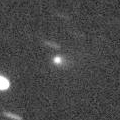
|
First return of a new periodic comet which brightened up to 16 mag in 2014. Now it is 16.9 mag (July 5, Thomas Lehmann). It stays observable at 16-17 mag in good condition until July.
Date(TT) R.A. (2000) Decl. Delta r Elong. m1 Best Time(A, h)
Aug. 14 13 38.39 -14 21.1 2.333 2.148 66 17.8 20:22 ( 62, 12)
Aug. 21 13 50.53 -16 1.3 2.404 2.154 63 17.9 20:11 ( 62, 10)
|

|
First return of a new periodic comet observed at 17 mag in 2014. It has not been observed yet in this apparition. The orbital elements are improved based on the new observations from June to July in 2014, and the perihelion date moved about 1 month earlier. It is expected to brighten up to 18 mag in summer, and it will be observable in good condition.
Date(TT) R.A. (2000) Decl. Delta r Elong. m1 Best Time(A, h)
Aug. 14 3 25.64 28 32.6 1.677 1.881 84 17.9 3:46 (274, 62)
Aug. 21 3 36.63 29 34.8 1.638 1.911 89 17.9 3:53 (276, 67)
|

|
It stays 17 mag for a long time from 2021 to 2022. It is observable in excellent condition in the Northern Hemisphere, It locates somewhat low in the Southern Hemisphere.
Date(TT) R.A. (2000) Decl. Delta r Elong. m1 Best Time(A, h)
Aug. 14 5 39.67 31 32.9 6.139 5.634 55 18.0 3:46 (253, 36)
Aug. 21 5 39.38 31 48.4 6.011 5.618 62 17.9 3:53 (257, 43)
|

|
It brightened up to 13.8 mag in autumn in 2019 (Sept. 3, 2019, Chris Wyatt). Now it is fading slowly. It stays 18 mag until autumn.
Date(TT) R.A. (2000) Decl. Delta r Elong. m1 Best Time(A, h)
Aug. 14 0 45.04 21 39.1 7.726 8.292 120 17.9 3:16 ( 0, 77)
Aug. 21 0 42.85 21 53.3 7.680 8.335 127 17.9 2:46 ( 0, 77)
|
|
![]()
 C/2020 K1 ( PanSTARRS )
C/2020 K1 ( PanSTARRS ) C/2021 D2 ( ZTF )
C/2021 D2 ( ZTF ) C/2019 K7 ( Smith )
C/2019 K7 ( Smith ) 110P/Hartley 3
110P/Hartley 3 193P/LINEAR-NEAT
193P/LINEAR-NEAT C/2020 S3 ( Erasmus )
C/2020 S3 ( Erasmus ) 402P/2020 Q3 ( LINEAR )
402P/2020 Q3 ( LINEAR ) 52P/Harrington-Abell
52P/Harrington-Abell 119P/Parker-Hartley
119P/Parker-Hartley 104P/Kowal 2
104P/Kowal 2 241P/LINEAR
241P/LINEAR C/2017 T2 ( PanSTARRS )
C/2017 T2 ( PanSTARRS ) 28P/Neujmin 1
28P/Neujmin 1 C/2017 Y2 ( PanSTARRS )
C/2017 Y2 ( PanSTARRS ) C/2020 U5 ( PanSTARRS )
C/2020 U5 ( PanSTARRS ) C/2020 F2 ( ATLAS )
C/2020 F2 ( ATLAS ) P/2021 L5 ( La Sagra )
P/2021 L5 ( La Sagra ) 395P/2020 H1 ( Catalina-NEAT )
395P/2020 H1 ( Catalina-NEAT ) P/2021 N2 ( Fuls )
P/2021 N2 ( Fuls ) C/2020 T4 ( PanSTARRS )
C/2020 T4 ( PanSTARRS ) C/2017 U7 ( PanSTARRS )
C/2017 U7 ( PanSTARRS ) 88P/Howell
88P/Howell P/2021 L1 ( Christensen )
P/2021 L1 ( Christensen ) 378P/2019 E2 ( McNaught )
378P/2019 E2 ( McNaught ) 152P/Helin-Lawrence
152P/Helin-Lawrence 413P/2020 W4 ( Larson )
413P/2020 W4 ( Larson ) P/2014 W12 ( Gibbs )
P/2014 W12 ( Gibbs ) C/2020 U4 ( PanSTARRS )
C/2020 U4 ( PanSTARRS ) C/2017 B3 ( LINEAR )
C/2017 B3 ( LINEAR )![]()



































































